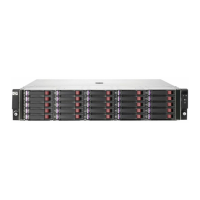Clustering and fabric zoning
If you plan to use clustering, install and configure the clustering software on the servers.
Clustering is the organization of multiple servers into groups. Within a cluster, each server is a
node. Multiple clusters compose a multi-cluster environment. The following example shows a
multi-cluster environment with three clusters, each containing two nodes. The nodes share access
to the disk array.
Figure 8 Multi-cluster environment (Solaris)
Within the SAN, the clusters can be homogeneous (all the same operating system) or heterogeneous
(mixed operating systems). How you configure LUN security and fabric zoning depends on the
operating system mix and the SAN configuration.
Fabric Zoning and LUN security for multiple operating systems
Array Manager offers the ability to limit access to a given host to a specific host/WWN.
• Security must be enabled for LUN isolation when multiple hosts connect through a shared
array port. See the HP StorageWorks SAN Design Reference Guide (http://www.hp.com/
go/sandesign) for fabric zoning and LUN security configuration rules.
Connecting the disk array
The HP service representative performs the following steps to connect the disk array to the host:
1. Verifying operational status of the disk array channel adapters, LDEVs, and paths.
2. Connecting the Fibre Channel cables between the disk array and the fabric switch or host.
3. Verifying the ready status of the disk array and peripherals.
Connecting the disk array 83

